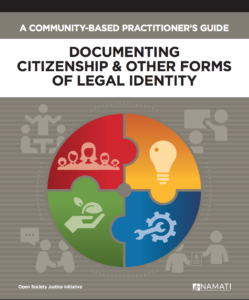A Community-Based Practitioner’s Guide: Documenting Citizenship and Other Forms of Legal Identity
By: Namati and Open Society Justice Initiative, in cooperation with UNHCR
Today, 1.1 billion people around the world lack legal identity documentation. Without it, they cannot vote, access healthcare, or go to school—and are at risk of becoming stateless. Entire communities—especially the poor and members of minority groups—may lack documentation, leaving them legally and politically invisible. The lack of effective citizenship prevents millions from realizing their rights and reaching their full potential.
Unfortunately, gaining access to legal identity documents can be difficult or even impossible. In theory, governments should provide documents to their citizens, but in reality, the process is complicated by burdensome bureaucracies, distant offices, and even discriminatory officials.
Based on the experiences of dozens of existing projects, and drawing on lessons from across the globe, this guide provides step-by-step instructions on establishing paralegal or other community-based program to help people obtain legal identity documents. An essential tool for practitioners, it uses case studies, infographics, and copies of actual forms to guide the reader through the process of documenting citizenship and other forms of legal identity.
Para una versión en español de la guía, clic aquí.
—–
Readers are invited to share their comments, questions and ideas with the guide’s authors and contributors and the broader community via this post on the Global Legal Empowerment Network’s online forum.

